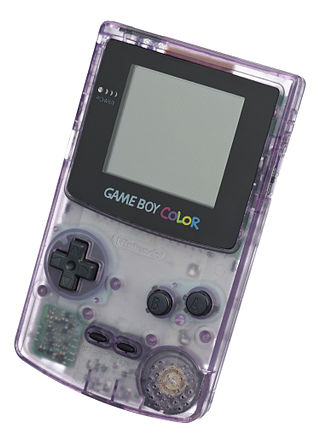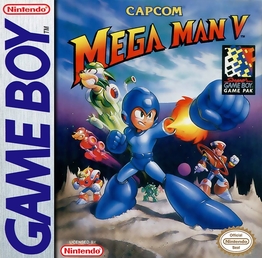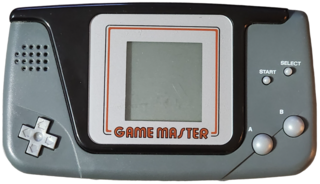
The Game Boy Advance (GBA) is a 32-bit handheld game console, manufactured by Nintendo, which was released in Japan on March 21, 2001, and to international markets that June. It was later released in mainland China in 2004, under the name iQue Game Boy Advance. Compared to the Game Boy Color it replaced, the console offered far more powerful ARM7 processor and vastly improved graphics, while retaining backward compatibility with games initially developed for its predecessor.

The Game Boy Color is an 8-bit handheld game console, manufactured by Nintendo, which was released in Japan on October 21, 1998, and to international markets that November. Compared to the original Game Boy, the Game Boy Color features a color TFT screen rather than monochrome, a processor that can operate twice as fast, and four times as much memory. It retains backward compatibility with games initially developed for its predecessor.

A handheld game console, or simply handheld console, is a small, portable self-contained video game console with a built-in screen, game controls and speakers. Handheld game consoles are smaller than home video game consoles and contain the console, screen, speakers, and controls in one unit, allowing players to carry them and play them at any time or place.

Mario Tennis is a 2000 sports video game developed by Camelot Software Planning and published by Nintendo for the Nintendo 64 (N64). Following Mario's Tennis, it is the second game in the Mario Tennis series. The game is known for being the introduction of Luigi's arch-rival, Waluigi, and the re-introduction of Princess Daisy and Birdo.

Tetris Attack, also known as Panel de Pon in Japan, is a puzzle video game developed by Intelligent Systems and published by Nintendo for the Super Nintendo Entertainment System. A Game Boy version was released a year later. In the game, the player must arrange matching colored blocks in vertical or horizontal rows to clear them. The blocks steadily rise towards the top of the playfield, with new blocks being added at the bottom. Several gameplay modes are present, including a time attack and multiplayer mode.

The Super Game Boy is a peripheral that allows Game Boy cartridges to be played on a Super Nintendo Entertainment System console. Released in June 1994, it retailed for US$59.99 in the United States and £49.99 in the United Kingdom. In South Korea, it is called the Super Mini Comboy and was distributed by Hyundai Electronics. A revised model, the Super Game Boy 2, was released in Japan in January 1998.

The Game Boy Player is a GameCube peripheral developed by Nintendo which enables it to play Game Boy, Game Boy Color, and Game Boy Advance cartridges, allowing those games to be played on a television.

Mega Man V is a video game published by Capcom for the Game Boy handheld game console. It is the fifth game in the Game Boy version of the original Mega Man series. The game follows the adventures of the protagonist Mega Man as he must defend the Earth from a group of powerful robots from outer space called the Stardroids. Mega Man V is unique among the Game Boy Mega Man games as it features original bosses rather than recycling those from the Nintendo Entertainment System (NES) Mega Man games.
The Virtual Console was a line of downloadable retro video games for Nintendo's Wii and Wii U home video game consoles and the Nintendo 3DS family of systems. The Virtual Console lineup consisted of titles originally released on past home and handheld consoles and were run in their original forms through software emulation, therefore remaining mostly unaltered, and could be purchased from the Wii Shop Channel or Nintendo eShop for between 500 and 1200 Wii Points, or using real currency, with prices depending on the system, rarity, and/or demand.

Game Boy Wars is a turn-based strategy video game developed by Nintendo and Intelligent Systems and published by Nintendo for the Game Boy. Released only in Japan, it is a portable follow-up to the 1988 Family Computer wargame Famicom Wars, making it the second game in Nintendo's Wars series. A series of sequels to the original Game Boy Wars were developed and released by Hudson Soft.

The Game Boy is a handheld game console developed by Nintendo, launched in the Japanese home market on April 21, 1989, followed by North America later that year and other territories from 1990 onwards. Following the success of the Game & Watch single-game handhelds, Nintendo developed the Game Boy to be more like a portable console, with interchangeable cartridges. The concept proved highly successful and the Game Boy became a cultural icon of the 1990s and early 2000s.

The Nintendo Game Link Cable is an accessory for the Game Boy line of handheld video game systems, allowing players to connect Game Boys of all types for multiplayer gaming. Depending on the games, a Game Link Cable can be used to link two games of the same title, like Tetris, or two compatible games like Pokémon Red and Blue. Games can be linked for head-to-head competition, cooperative play, trading items, unlocking hidden features, etc.
This is a list of video game accessories that have been released for the Game Boy handheld console and its successors. Accessories add functionality that the console would otherwise not have.

The Game Master is a handheld game console manufactured by Hartung, and designed to compete with the Nintendo Game Boy. In Germany, it was marketed by Hartung itself, while in the UK it was released as the Systema 2000 by the already well-established maker of cheap LCD games Systema.
Konami GB Collection is a series of video game compilations composed of four volumes released in Japan for the Game Boy and re-released in Euro regions for the Game Boy Color. The compilations were originally released from 1997 to 1998 in Japan, and were later released in Europe in 2000.

The Japanese multinational consumer electronics company Nintendo has developed seven home video game consoles and multiple portable consoles for use with external media, as well as dedicated consoles and other hardware for their consoles. As of September 30, 2021, in addition to Nintendo Switch, Nintendo has sold over 863.07 million hardware units.













